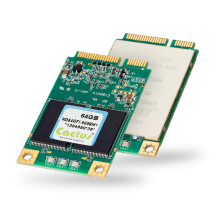mSATA Speed and Performance 101

SATA Interface flash storage devices continue to eat away at the IDE/PATA interface in the embedded system marketplace.This post focuses on the speed and performance of one particular embedded SATA module - the mSATA form factor.mSATA drive have 50.8mm x 29.85mm length and width providing a limited amount of space for components. Typically a controller, possibly some variety of DRAM and up to 4 NAND flash components.
Burst Performance versus Sustained Performance
DRAM cache is used on some mSATA SSD to improve performance. The larger the capacity of the DRAM component, the better the performance gain, especially when writing. This is due to DRAM having a much higher performance than the NAND flash which later stores the data.
A word of caution. Since DRAM is volatile memory, the data temporarily stored in the DRAM cache during operation is susceptible to loss during unexpected power loss. For this reason many of the Industrial mSATA do not use external DRAM components.
Speed Limited by number of NAND Components
 Increased performance is gained on flash storage devices by striping across many NAND components. Striping signifies reading and writing simultaneously to more than one NAND device, thereby multiplying the performance by the number of NAND devices.Typical 2.5” SATA SSD strip across 8 to 10 NAND since there is plenty of physical space for many NAND components. mSATA SSD are physically limited to 4 NAND components, this limits the ability to strip across more NAND components simultaneously.
Increased performance is gained on flash storage devices by striping across many NAND components. Striping signifies reading and writing simultaneously to more than one NAND device, thereby multiplying the performance by the number of NAND devices.Typical 2.5” SATA SSD strip across 8 to 10 NAND since there is plenty of physical space for many NAND components. mSATA SSD are physically limited to 4 NAND components, this limits the ability to strip across more NAND components simultaneously.Type of NAND Flash effects Performance
The read speeds for SLC and MLC NAND flash are similar, but the large block sequential and random write speed is much faster with SLC NAND flash.
Small block write performance is not effected much by SLC or MLC NAND. Since the command overhead of the NAND components consume a large portion of the latency.
Cactus is available to discuss your OEM application in-depth to help you make an informed decision. Let us know if you need more information?






